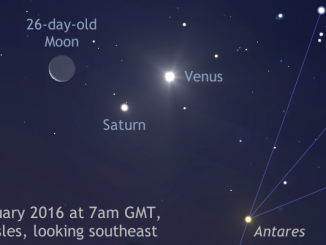
Data collected by NASA’s Cassini spacecraft during its final few orbits of Saturn are adding new insights into the nature of the ringed planet’s magnetic field.
Saturn’s interior is thought to be made up of a central ice/rock core, surrounded by a layer of electrically conducting metallic hydrogen that generates the dynamo responsible for the planet’s magnetic field. Moving out from the deep interior, the metallic hydrogen transitions to an insulating outer layer consisting mostly of molecular hydrogen.
Based on data collected by Cassini, researchers at Johns Hopkins University conclude the observed magnetic field can best be explained by a transition layer in the deep interior made up of helium “rain.”
Below the transition zone, the pressure is so high that helium can mix smoothy with the metallic hydrogen, allowing convection and the dynamo action that generates the planet’s magnetic field. At lower pressures, farther from the core, the helium is immiscible in hydrogen, causing it to rain out.
The helium rain, it is thought, would act to inhibit convection and the dynamo action, providing a good fit with the Cassini data.
“One thing we discovered was how sensitive the model was to very specific things like temperature,” said Sabine Stanley, a Johns Hopkins planetary physicist and co-author of a paper in AGU Advances. “And that means we have a really interesting probe of Saturn’s deep interior as far as 20,000 kilometres down. It’s a kind of X-ray vision.”



